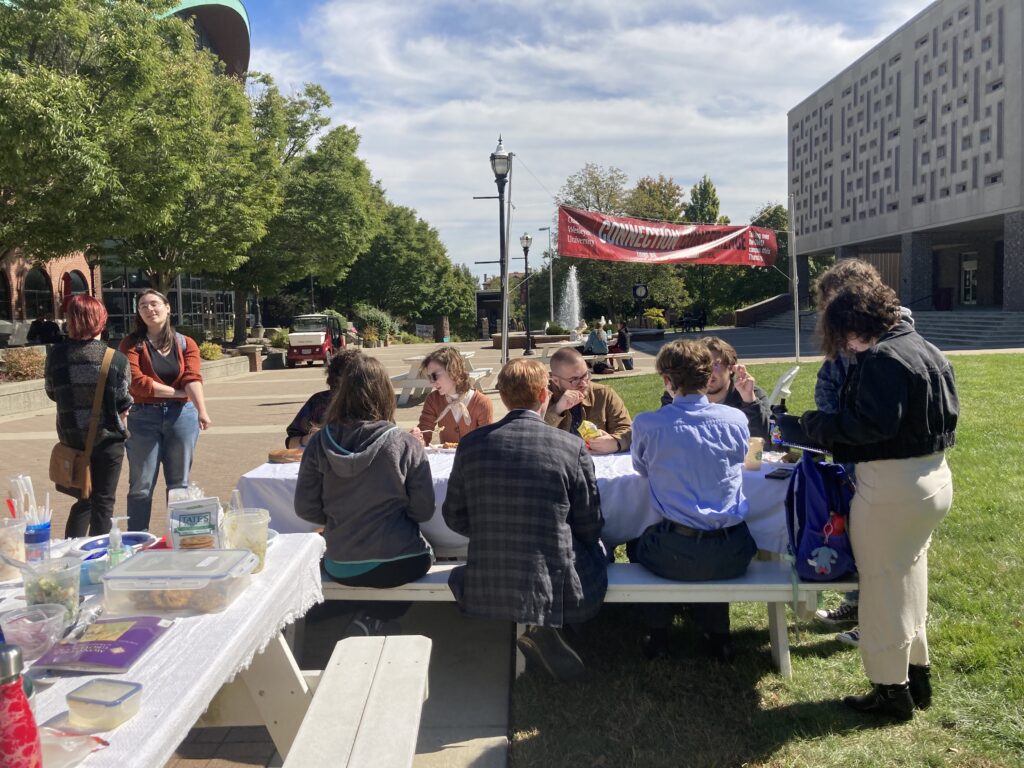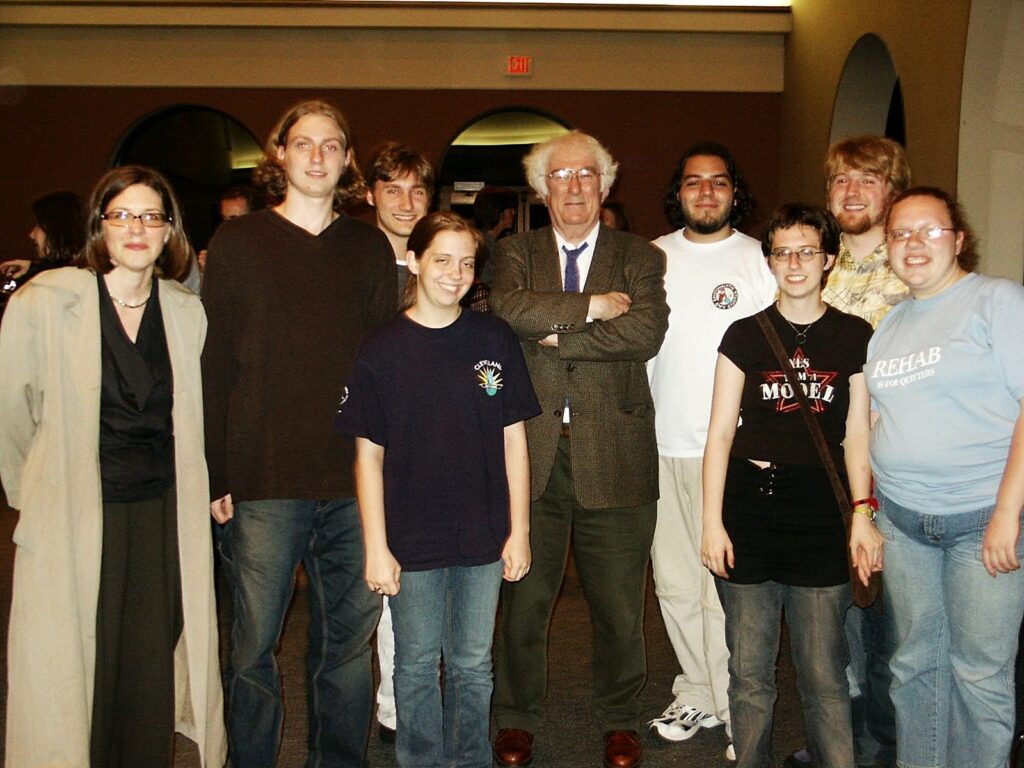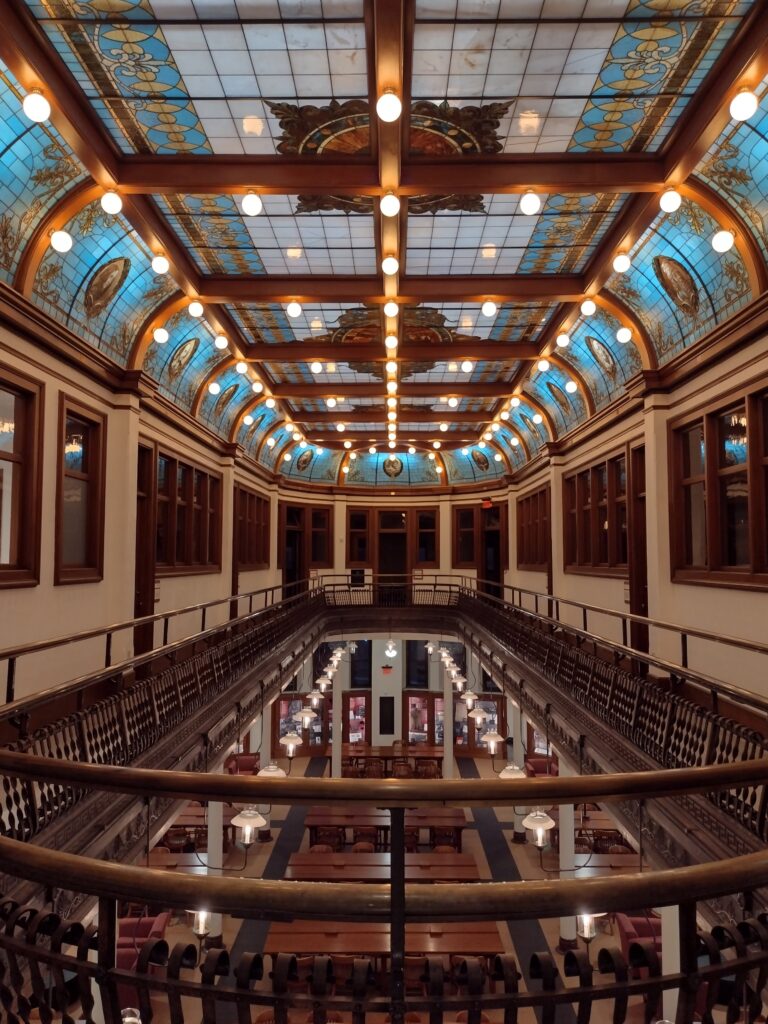“This is my friend, and she’s majoring in Medieval Studies, the coolest major ever.” My freshman year, I met a student who was majoring in Medieval Studies, and that became my go-to method for introducing her. But as an aspiring Creative Writing major whose admittedly narrow image of the Middle Ages consisted of boring battles and tiresome religious feuds, I respected the subject, at the time, but had little interest in pursuing the subject academically.
However, I came to realize, as have many students, that the Ancient, Medieval, and Renaissance (AMRS) program at Ohio Wesleyan University is so much more than the historical facts themselves, facts which become far more interesting when presented through a variety of lenses. I spoke with three alumni who majored or minored in the program to see how it changed their undergraduate studies and later careers. Their memories of the AMRS program gems crystallized around the people they learned alongside—people through whom history shone all the brighter.
An Interdisciplinary Approach
“To this day, some of my favorite people in the world are folks I met through the AMRS program,” explains 2005 graduate Emily Burkot, who double-majored in Medieval and Renaissance Studies.

Outside of classes, the department and its faculty often organize events. Burkot reminisces on movie nights and off campus trips. Josie DiNovo, a 2016 graduate with a Medieval Studies minor, remembers attending social gatherings at professors’ houses. In recent years, the semesterly AMRS picnic, spearheaded by AMRS director Dr. Patrica DeMarco, draws in students who walk by the JAYwalk with the sight and smell of Dr. DeMarco’s portable table grill and the sound of pleasant chatter among students and professors. From bocce ball to singed tablecloths, the picnic is always sure to deliver delightful competition, brushes with death, and food.
The caring, excellent faculty drew DiNovo, and many students, into the AMRS program. Burkot had a similar experience with faculty, and she was invited by special collections librarian Hilda Wick to work with manuscripts and incunabula, books printed prior to 1500, in Beeghly Library’s rare book room. It is these little yet unique details and opportunities that have stuck with many alumni and painted their undergraduate studies in unique, interdisciplinary colors.
“My goal was to try everything, and this program encouraged that willingness to stretch,” Burkot says. She took music, art, philosophy, and language classes, reveling in the variety of options.
“My goal was to try everything, and this program encouraged that willingness to stretch.”

Alumnus, poet, Creative Writing Club co-founder, and English Literature major Lee Seigel also found freedom in the variety of classes he was able to take for his Medieval Studies and History minors. He believes it is very important to enjoy what you study, and the program allowed him to follow his interests in nearly every humanities department, from English and Classics to History and Art.
“They overlapped into a well of classes that reinforced each other,” Seigel explains.
The personal nature of the program allows students to go in their own direction of study, and Seigel dove into medieval poetry wholeheartedly. Such flexibility exposes students to new material they may not have otherwise approached.
With this degree of freedom to choose her curriculum, DiNovo took a history of the English language course—”linguistics for babies,” she describes—a class she admittedly didn’t know she wanted until she was there.
As an English Literature and German Studies double-major with a History and Medieval Studies double-minor, DiNovo has always liked history, and the interdisciplinary aspect of the AMRS program allowed her to combine her varied interests. As the Bard of Avon so describes the vocabulary of lovers, so could one describe the program as “a very fantastical banquet, just so many strange dishes.”1 “Yum,” is DiNovo’s more efficient description.
“Just give it a try,” she urges current students. “there’s something for everyone.”
The interdisciplinary aspect of the program is not only in the array of offered classes, of course, but also in the connections between them and to the world at large. In an introductory class about early modern European history, DiNovo studied modern issues, such as jail systems, by looking into the past.

“How we handled the past affects how we handle these things now,” DiNovo explains. The program challenges students to “see the connections.”
“How we handled the past affects how we handle these things now—it challenges you to see the connections.”
The connections this program builds range from social issues to the media we consume on a regular basis. Interested in Classics from a young age, Seigel started his studies at OWU in the Classics before moving into a Medieval concentration. His Medieval studies—especially the Middle English le Morte d’Arthur—reinforced an ever-growing respect and love for artistic and literary works from all time periods. For example, no other study can better illuminate how medieval literary traditions inspired J. R. R. Tolkien’s Lord of the Rings, which Seigel was assigned to read while studying quest narratives. Additionally, the acclaimed Sandman comics by Neil Gaiman, Seigel explains, make use of many mythologies, including Greco-Roman, Norse, and Indian. Gaiman’s own religion and history studies—favorite subjects of his while in school—allowed him to draw inspiration from this wide selection of source material.2
All the World’s a Stage
As much as some may prefer to remain in the Edenic haven of undergraduate bliss, the credits do eventually add up and throw even the most indecisive AMRS student into the world with a degree in hand and a head full of ancient poetry. Each of the alum here has followed a career path whose trails, while unique in their specifics, are not uncommon in their winding nature.
Upon graduation, Burkot discovered that her local library’s summer reading program had a medieval theme. From volunteering that summer to eventually getting hired, she worked with teenagers at the library to get them excited about history.
“My not-so-secret mission in life is to make history—specifically Medieval and Renaissance—interesting for non-history folks,” says Burkot. “My experience of history is that it is dramatic, it is funny, and sometimes it is even spicy.”

After earning a master’s degree in Library Sciences, Burkot is now a librarian at a private high school, continuing to encourage teenagers to dive into the history that most excites them and talking about her specialty in classrooms on occasion.
On a more winding path, DiNovo did a handful of freelancing jobs, including some translation, before working as a market research copy editor for a few years. Eventually, she landed an editorial assistant position at Penn State University, where she enjoys being able to work in the academic field even without a Masters degree. She works in the acquisitions department in a variety of genres, from Jewish literature to graphic novels and memoirs. She felt right at home when she began working at Penn State, even though the coveted medieval literature department position escaped her grasp. Her AMRS studies at OWU gave her skills in close reading, analysis, critical thinking, and overcoming and appreciating language barriers as she works with people who speak other languages.
The AMRS program can enrich the life of anyone, no matter their career goals. Seigel can’t imagine his life without having studied in this program, maintaining still connections with the faculty and his fellow students. While not having a direct impact on his career, his Medieval Studies minor has made him a more enriched writer, communicator, and human. An example of the sorts of connections OWU prides itself in, Seigel ran a small business selling laptops with a fellow alum he met at a student involvement fair one year. He later began working for the Ohio Democratic Party as an IT director and is now in progressive fundraising, where he writes and enjoys a more creative career.
“Humanity was stripped away to its essence in the Middle Ages—what stories come out of that?”
The kinds of classes offered by the program cover a long period of time, giving students an enormously wide lens through which to gain “insight into humanity,” says Seigel, reflecting on the deeper impact of his studies.
The morphing of real historical figures into legends, such as King Richard, has always compelled Seigel. Medieval literature captures this path to becoming mythological alongside themes of sacrifice, as in The Song of Roland, all while displaying the often simple brutality of medieval life: “Humanity was stripped away to its essence in the Middle Ages—what stories come out of that?” wonders Seigel. Many of the universal components of medieval literature owe themselves to the honest, truthfully brutal nature of humans during this period.
To adventure into the Ancient, Medieval, and Renaissance program—to dare step into its dragon’s hoard of gold and gemstones—is to open your eyes to the density of human history in all that surrounds us: in our art, in our media, in our architecture, and in our stories.
1 Shakespeare, William. Much Ado About Nothing. The Folger Shakespeare, https://shakespeare.folger.edu/shakespeares-works/much-ado-about-nothing/entire-play/
2“Neil Gaiman,” David Tennant Does a Podcast With…, Somethin’ Else and No Mystery, 12 Oct 2020, https://open.spotify.com/episode/4hlguLVKEGIkbCctEur8v9?si=8e92cb415dbf4af4
a “Le Morte Darthur.” The British Library, Public domain. https://www.bl.uk/collection-items/thomas-malorys-le-morte-darthur
Cover photo by editor